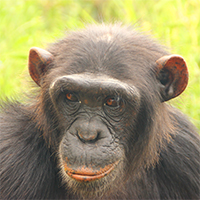The Chimps of Ol Pejeta


Image credit: Ol Pejeta Conservancy
“What are they? They surely look bigger than monkeys. Are they also monkeys?” the little child asks the tour guide when they stop in front of one of the enclosures at the Sweetwaters Chimpanzee Sanctuary at Ol Pejeta Conservancy. The child is confused. The animal in front of them looks like a monkey but isn’t.
“They aren’t monkeys. These are chimpanzees. See right there,” says the guide while pointing to a chimp’s backside, “There’s no tail. Monkeys have really long tails.”
The tour guide then takes them round the corner to where the male chimpanzees are. The child marvels at how big one of the male chimps are.
“That’s Oscar, the alpha male,” the tour guide points at the largest chimpanzee in the enclosure.
“He’s the leader of the pack. Right next to him are his allies, his ‘right-hand men’. Oscar was born in 1997. Before he became the alpha male, his father occupied that position.”
“How did Oscar replace his dad as the leader?” the child inquires.
“Well, there’s a number of ways a male chimp can be the leader. He can use sheer force and just take the position. That’s what Oscar did. Others get the position by simply making allegiances and pacts with other chimpanzees and this enhances their position into the alpha male,” the tour guide says.

Image credit: Ol Pejeta Conservancy
The tour guide moves them along to where the female chimpanzees are housed. Here, the child spots another chimp with a younger chimpanzee hanging off its back while swinging from one tree branch to another.
“Who is that?” the child asks in complete awe.
“That right there is Saidia. She was brought here in 2003 from South Sudan where she had suffered severe burns. She was treated and now as you can see, she is fully active and healthy.”

Image credit: Ol Pejeta Conservancy
“How can you tell the difference between the males and the females?” asks the child.
“Unlike the male chimpanzees, females are more relaxed and not as aggressive. They tend to be more nurturing,” the guide says.
“Having fun?” The guide asks the child and is answered with a nod and a wide grin. “Come on. I want you to see what else they can do.”
The guide moves the family along to another group of chimpanzees. This time, one of them has a stick in hand digging the ground.
“Chimpanzees are extremely intelligent in using items in their surroundings to get food. That one’s using the stick to search for little dudus on the ground,” the guide tells the child.
“Ewwwww,” the child says and wrinkles their nose upon realising insects are actually eaten by other animals.
The guide turns to the child grinning, “Well, they don’t only eat insects. They eat plants as well as other kinds of meat. We call such animals omnivores.”
As the tour group rounds off at the final corner, the guide turns to the child once again. “Chimps also have a great range when it comes to their habitat, with most residing in tropical rainforests. Some populations can be found in woodlands across Western and Central Africa. They usually sleep on tress that are firm, usually the Ugandan ironwood tree. They also build their nests on the tress with leaves.”
“Unfortunately, these great beasts were declared endangered species by The International Union for the Conservation of Nature as more and more humans creep into their habitats looking for land for their own use. This is one of the reasons the Ol Pejeta Conservancy exists. To create a home for the chimpanzees and reduce the danger they face,” says the tour guide as he concludes the tour.



